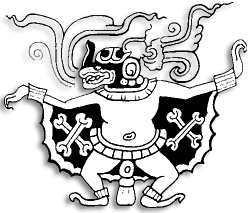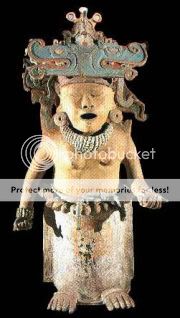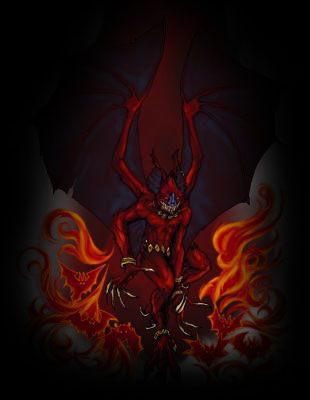|
Aztec Vampires : Camazotz, Chonchon and Cihuateteo :
CAMAZOTZ :
The cult of Camazotz began around 100 B.C. among the Zapotec Indians in what is the modern-day Mexican state of Oaxaca. The cult of Camazotz worshiped an anthropomorphic monster with the body of a human, head of a bat (though the exact proportioning varies with account). The bat was associated with night, death, and sacrifice. This god soon found its way into the pantheon of the Quiché, a tribe of Maya who made their home in the jungles of what is now Guatemala. The Quiché identified the bat-deity with their god Zotzilaha Chamalcan, the god of fire.

There is some evidence to support that the Camazotz myth may have sprung from actual large, blood-drinking bats of the Mexico, Guatemala, and Brazil areas. Evidence is in the form of fossils of Desmodus draculae, the giant vampire bat. There have also been skeletons of D. draculae found which were sub-fossil, of very recent age. These sub-fossils suggest that the species were still common when the Mayans civilization existed, and may still be in existence today, though it is doubtful. Alternately, Camazotz may have originated from the Spectral Bat, a large carnivorous bat native to Central and South America.
In the Popol Vuh, a Mayan sacred book, the common noun refers to bat-like monsters encountered by the Maya Hero Twins Hunahpu and Xbalanque during their trials in the underworld of Xibalba. Forced to spend the night in Bat House, the boys are able to keep the creatures at bay until Hunahpu loses his head while trying to watch for the coming of dawn. The grieving Xbalanque calls all the animals, instructing each to bring back its favorite food. When the coati returns with a squash, Xbalanque carves it into a new head for his brother, and they continue their adventures, bringing about the eventual defeat of the Xibalbans.
Popol Vuh, identifies Zotzilaha as not a god, but a cavern, "The House of Bats". Zotzilaha was home to a type of bat called camazotz; one of these monsters decapitated the hero Hunahpú. Camazotz has been translated as "death bat" and "snatch bat". It is recorded in chapter 10 of this book that the Camazotz's call was similar to eek, eek . A vastly different story appears in Chapter 3. Here a demon called Camalotz, or "Sudden Bloodletter", clearly a single entity, is identified as one of four animal demons which slew the impious first race of men .

In the Latin American region, it seems that the ancient belief in the "death bat" survives even to the present day. Several cultures have traditions of bat-demons or winged monsters; for example, legends of the h?ik'al, or Black-man, still circulate among the Zotzil people of Chiapas, Mexico. Perhaps revealingly, the H?ik'al is sometimes referred to as a "neck-cutter" . Other bat-demons include the soucouyant of Trinidad and the tin tin of Ecuador .

The CHONCHON of Peru and Chili :
A creature, that is much like the Camazotz, appears in the folklore of rural Peru and Chile. The chonchon is a vampire-type monster; and it is truly bizarre, even for a legendary creature. It is said that after a person's death, the head will sometimes sprout enormous ears and lift off from the shoulders. This flying head is the Chonchon; its sound, as recorded by Jorge Luis Borges, was like tui-tui-tui . Could the legends of the Chonchon have sprung from the same source as the Camazotz legends?
There was a report of a bat-like monster, a story told by a Brazilian couple, the Reals. One night in the early 1950s, they were walking through a forest outside of Pelotas, Brazil, when they saw two large "birds" in a tree, both of which alighted on the ground . Although reported as winged humanoids, the proximity of the sighting area to the Ribeira Valley, where the Brazilian specimen of D. draculae was found, forces one to wonder whether the Reals' "birds" were actually bats.
In March, 1975, a series of animal mutilations swept the countryside near the Puerto Rican town of Moca, and during the incident a man named Juan Muñiz Feliciano claimed that he was attacked by a large, gray-feathered creature. These bird-like creatures were seen numerous times during the outbreak.
These reports didn't gain real notoriety until the mid-1970s, when a number of sightings of large birds or bats surfaced in Rio Grande Valley, Texas. The first report came from the town of San Benito, where three people reputedly encounters with a bald-headed creature . But rumors had long circulated among the Mexican inhabitants of the town about a large bird-like creature, believed to make tch-tch-tch sounds .
On New Year's Day, 1976, two girls near Harlingen watched a large, birdlike creature with a "gorilla-like" face, a bald head, and a short beak. The next day, a number of three-toed tracks were found in the field where the creature had stood . On January 14, Armando Grimaldo said he was attacked by the creature at Raymondville. He said it was black, with a monkey's face and large eyes . Further reports surfaced from Laredo and Olmito, with a final sighting reported from Eagle Pass on January 21 .
The reports cited above, as well as countless others which await careful researchers, support a conclusion that a mysterious winged creature exists in the deserts and jungles of Mesoamerica. The prominence of the bat in Latin American mythology and the discovery of the recently-extinct Desmodus draculae in South America point to the possible identity of the creature as a large, as-of-yet unknown bat, rather than a living pterosaur, as is generally supposed.
CIHUATETEO :

In Aztec mythology, the Cihuateteo (also Ciuteoteo, Ciuateoteo or Civateteo; singular Ciuateotl or Cihuateotl, lit. goddess) were the spirits of human women who died in childbirth (mociuaquetzque.).
The Cihuateteo are : Five female spirit sisters of Macuiltonaleque.
Childbirth was considered a form of battle, and its victims were honored as fallen warriors. Their physical remains were thought to strengthen soldiers in battle while their spirits became the much-feared Cihuateteo who accompanied the setting sun in the west. They also haunted crossroads at night, stealing children and causing sicknesses, especially seizures and madness, and seducing men to sexual misbehavior.

Their images appear with the beginning day signs of the five western trecena, (1 Deer, 1 Rain, 1 Monkey, 1 House, and 1 Eagle) during which they were thought to descend to the earth and cause particularly dangerous mischief. They are depicted with skeletal faces and with eagle claws for hands.
They are associated with the goddess Cihuacoatl and are sometimes considered envoys of Mictlan, the world of the dead. Cihuateteo are servants of the Aztec moon deities Tezcatlipoca and Tlazolteotl.
I hope you enjoyed this summary of Aztec Vampires.
|












